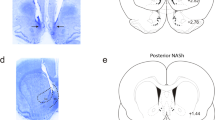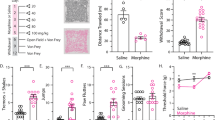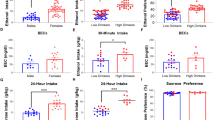Abstract
Although many anecdotal reports indicate that marijuana and its active constituent, delta-9-tetrahydrocannabinol (delta-9-THC), may reduce pain sensation1,2, studies of humans have produced inconsistent results3,4,5,6. In animal studies, the apparent pain-suppressing effects of delta-9-THC and other cannabinoid drugs7,8,9,10,11,12 are confounded by motor deficits13,14. Here we show that a brainstem circuit that contributes to the pain-suppressing effects of morphine15 is also required for the analgesic effects of cannabinoids. Inactivation of the rostral ventromedial medulla (RVM) prevents the analgesia but not the motor deficits produced by systemically administered cannabinoids. Furthermore, cannabinoids produce analgesia by modulating RVM neuronal activity in a manner similar to, but pharmacologically dissociable from, that of morphine. We also show that endogenous cannabinoids tonically regulate pain thresholds in part through the modulation of RVM neuronal activity. These results show that analgesia produced by cannabinoids and opioids involves similar brainstem circuitry and that cannabinoids are indeed centrally acting analgesics with a new mechanism of action.
This is a preview of subscription content, access via your institution
Access options
Subscribe to this journal
Receive 51 print issues and online access
$199.00 per year
only $3.90 per issue
Buy this article
- Purchase on Springer Link
- Instant access to full article PDF
Prices may be subject to local taxes which are calculated during checkout




Similar content being viewed by others
References
Mikuriya, T. H. Marijuana: Medical Papers 1839–1972. (Medi-Comp Press, Oakland, California, (1973)).
Dunn, M. & Davis, R. The perceived effects of marijuana on spinal cord injured males. Paraplegia 12, 175 (1974).
Noyes, R., Brunk, S. F., Avery, D. H. & Canter, A. The analgesic properties of delta-9-tetrahydrocannabinol and codeine. Clin. Pharmacol. Ther. 18, 84–89 (1975).
Clark, W. C., Janal, M. N., Zeidenberg, P. & Nahas, G. G. Effects of moderate and high doses of marihuana on thermal pain: a sensory decision theory analysis. J. Clin. Pharmacol. 21 (Suppl.), 299–310 (1981).
Libman, E. & Stern, M. H. The effects of delta-9-THC on cutaneous sensitivity and its relation to personality. Person. Indiv. Diff. 6, 169–174 (1985).
Holdcroft, A. et al. Pain relief with oral cannabinoids in familial Mediterranean fever. Anaesthesia 52, 483–488 (1997).
Buxbaum, D., Sanders-Bush, E. & Efron, D. Analgesic activity of tetrahydrocannabinol (THC) in the rat and mouse. Fed. Proc. 28, 735 (1969).
Sofia, R. D., Nalepa, S. D., Harakel, J. J. & Vassar, H. B. Anti-edema and analgesic properties of delta-9-tetrahydrocannabinol (THC). J. Pharmacol. Exp. Ther. 186, 646–655 (1973).
Moss, D. E. & Johnson, R. L. Tonic analgesic effects of delta-9-tetrahydrocannabinol as measured with the formalin test. Eur. J. Pharmacol. 61, 313–315 (1980).
Lichtman, A. H. & Martin, B. R. Cannabinoid-induced antinociception is mediated by a spinal α-noradrenergic mechanism. Brain Res. 559, 309–314 (1991).
Martin, W. J., Hohmann, A. G. & Walker, J. M. Suppression of noxious stimulus-evoked activity in the ventral posterolateral nucleus of the thalamus by a cannabinoid agonist: correlation between electrophysiological and antinociceptive effects. J. Neurosci. 16, 6601–6611 (1996).
Herzberg, U., Eliav, E., Bennett, G. J. & Kopin, I. J. The analgesic effects of R(+)-WIN 55,212-2 mesylate, a high affinity cannabinoid agonist, in a rat model of neuropathic pain. Neurosci. Lett. 221, 157–160 (1997).
Gough, A. L. & Olley, J. E. Delta-9-tetrahydrocannabinol and the extrapyramidal system. Psychopharmacol. 54, 87–99 (1977).
Ueki, S. Abnormal behavior induced by delta-9-tetrahydrocannabinol. Trends Pharmacol. Sci. 1, 126–129 (1980).
Mitchell, J. M., Lowe, D. & Fields, H. L. The contribution of the rostral ventromedial medulla to the antinoceceptive effects of systemic morphine in restrained and unrestrained rats. Neuroscience 87, 123–133 ((1998)).
Matsuda, L. A., Lolait, S. J., Brownstein, M. J., Young, A. C. & Bonner, T. I. Structure of a cannabinoid receptor and functional expression of the cloned cDNA. Nature 346, 561–564 (1990).
Munro, S., Thomas, K. L. & Abu-Shaar, M. Molecular characterization of a peripheral receptor for cannabinoids. Nature 365, 61–65 (1993).
Devane, W. A. et al. Isolation and structure of a brain constituent that binds to the cannabinoid receptor. Science 258, 1946–1949 (1992).
Stella, N., Schweitzer, P. & Piomelli, D. Asecond endogenous cannabinoid that modulates long-term potentiation. Nature 388, 773–778 (1997).
Rinaldi-Carmona, M. et al. SR 14176A, a potent and selective antagonist of the brain cannabinoid receptor. FEBS Lett. 350, 240–244 (1994).
Tsou, K., Brown, S., Sanudo-Pena, M. C., Mackie, K. & Walker, J. M. Immunohistochemical distribution of cannabinoid CB1 receptors in the rat central nervous system. Neuroscience 83, 393–411 (1998).
Basbaum, A. I. & Fields, H. L. Endogenous pain control systems: brainstem spinal pathways and endorphin circuitry. Annu. Rev. Neurosci. 7, 309–338 (1984).
Martin, W. J., Tsou, K. & Walker, J. M. Cannabinoid receptor-mediated inhibition of the rat tail-flick reflex after microinjection into the rostral ventromedial medulla. Neurosci. Lett. 242, 33–36 (1998).
Fields, H. L., Vanegas, H., Hentall, I. D. & Zorman, G. Evidence that disinhibition of brain stem neurones contributes to morphine analgesia. Nature 306, 684–686 (1983).
Fields, H. L., Malick, A. & Burstein, R. Dorsal horn projection targets of ON and OFF cells in the rostral ventromedial medulla. J. Neurophys. 74, 1742–1759 (1995).
Heinricher, M. M., Morgan, M. M. & Fields, H. L. Direct and indirect actions of morphine on medullary neurons that modulate nociception. Neuroscience 48, 533–543 (1992).
Pan, Z. Z. & Fields, H. L. Endogenous opioid-mediated inhibition of putative pain-modulating neurons in rat rostral ventromedial medulla. Neuroscience 74, 855–862 (1996).
Roychowdhury, S. M. & Fields, H. L. Endogenous opioids acting at a medullary µ-opioid receptor contribute to the behavioral antinociception produced by GABA antagonism in the midbrain periaqueductal gray. Neuroscience 74, 863–872 (1996).
Richardson, J. D., Aanonsen, L. & Hargreaves, K. M. Hypoactivity of the spinal cannabinoid system results in NMDA-dependent hyperalgesia. J. Neurosci. 18 ((1998)).
Cadas, H., di Tomaso, E. & Piomelli, D. Occurrence and biosynthesis of endogenous cannabinoid precursor, N-arachidonoyl phosphatidylethanolamine, in rat brain. J. Neurosci. 17, 1226–1242 (1997).
Paxinos, G. & Watson, C. The Rat Brain in Stereotaxic Coordinates (Academic Press, New York, (1986)).
Acknowledgements
This work was supported by the National Institute of Drug Abuse, the UCSF Center for the Neurobiology of Addiction and the Canadian MRC.
Author information
Authors and Affiliations
Corresponding author
Rights and permissions
About this article
Cite this article
Meng, I., Manning, B., Martin, W. et al. An analgesia circuit activated by cannabinoids. Nature 395, 381–383 (1998). https://doi.org/10.1038/26481
Received:
Accepted:
Issue Date:
DOI: https://doi.org/10.1038/26481
This article is cited by
-
Activation of CB1R alleviates central sensitization by regulating HCN2-pNR2B signaling in a chronic migraine rat model
The Journal of Headache and Pain (2023)
-
Cannabinoids: Current and Future Options to Treat Chronic and Chemotherapy-Induced Neuropathic Pain
Drugs (2019)
-
Why Does Increased Exercise Decrease Migraine?
Current Pain and Headache Reports (2013)
-
Exercise-induced endocannabinoid signaling is modulated by intensity
European Journal of Applied Physiology (2013)
-
Diencephalic and brainstem mechanisms in migraine
Nature Reviews Neuroscience (2011)
Comments
By submitting a comment you agree to abide by our Terms and Community Guidelines. If you find something abusive or that does not comply with our terms or guidelines please flag it as inappropriate.



